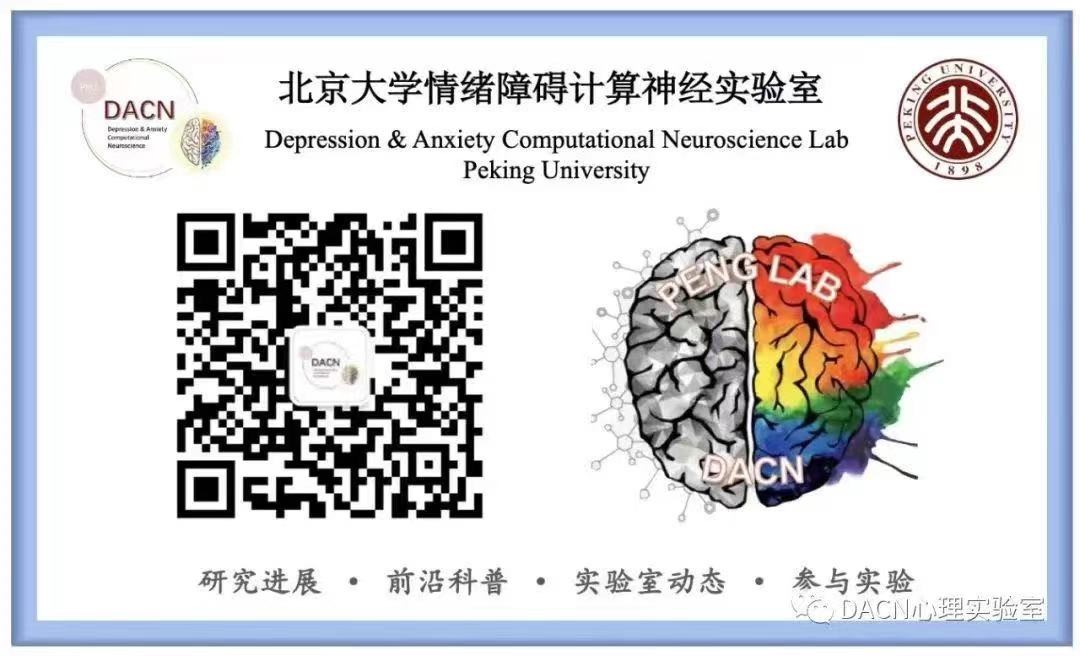目标和宗旨
彭玉佳研究员领导的抑郁与焦虑障碍计算神经实验室(Depression & Anxiety Computational Neuroscience Lab,DACN)主要聚焦于临床心理学的基础研究,并结合认知神经和人工智能的交叉研究,致力于探究抑郁和焦虑障碍的心理与神经机制以及治疗方法。
欢迎加入
- Ph.D.博士同学:我们是一个高度学科交叉的实验室,涉及临床心理学、计算精神病学、认知神经科学、人工智能等多学科研究内容,欢迎不同背景的同学加入我们。
- MAP硕士同学:我们不要求任何技术基础,我们将结合个人兴趣和实验室项目,找到属于你的心理健康或临床研究视角。
- RA:我们长期招募科研助理,以本科生科研、暑期科研等形式,参与实验室的课题,相信你可以获得你所需的科研锻炼并收获成果。
研究方法
- 问卷量表和访谈,线上调查和实验
- 行为学手段,包括心理物理学,眼动技术
- 脑成像,包括脑电,核磁共振成像,脑磁图和近红外成像
- 计算建模,机器学习
研究内容
- 计算精神病学及社交焦虑的先验偏差。通过计算模型和数据挖掘,来建模临床病人的认知特点,比较病人与常人的认知行为差异,理解精神疾病背后的机制,预期实现基于多维度数据的诊断和分类,以及发病的早期预测。社交恐惧症处于多种疾病交叉的中心,具有复杂的认知、情绪和行为的个体差异。然而,对于社交恐惧的理解还存在很多未知,并忽视了同样重要的且包含大量社会信息的身体运动和社交运动。实验室结合心理物理学、眼动捕捉、脑成像以及生理信号记录,从纵向的时间维度和横向的多数据维度,研究社交恐惧病人对于运动中社会信息的加工特异性。
- 社交媒体对于心理健康的影响。社交媒体的广泛使用对心理健康的影响备受关注。研究表明,过度使用社交媒体可能导致焦虑、抑郁和孤独感,尤其是青少年群体。负面效应常源于社交比较、网络欺凌和睡眠干扰。然而,社交媒体也能提供社会支持、增强人际联系,对心理健康有积极影响。个体差异、使用动机和内容类型是关键调节因素。实验室采用横断面和纵向追踪设计,探讨社交媒体使用与心理健康的关系。横断面调查将测量被试的社交媒体使用频率、内容偏好及心理健康指标;纵向追踪通过多次数据收集,分析使用模式的变化对心理健康的影响。
- 抑郁与焦虑障碍的认知神经机制。当前科学界对于抑郁症和焦虑症的发展机制还存在很多未知,难以实现精神疾病的早期诊断和预测。社交恐惧症是焦虑症中一个重要的分支,体现为对于社交行为和场合的极度焦虑和回避,严重影响了病人的正常工作和生活,且为病人就医和寻求治疗带来了极大的阻碍,从而形成一个恶性循环。从青春期至成年的过渡时期,该人生阶段伴随着前所未有的挑战、生活压力及人际关系,同时处于情绪和焦虑障碍发病的高峰时期。实验室主要关注大脑活动和情绪障碍症状维度随时间变化的关系。注重时间维度上的纵向追踪,探究从青春期至成年期的发病诱因和神经发展机制,以及环境和家庭因素对于情绪、认知和神经网络的调节。
- 精神疾病的创新治疗方法。实验室采用计算建模、数据挖掘和解码神经反馈等前沿技术,深入探索精神疾病的发病机制。通过构建临床病人的认知计算模型,系统比较其与健康人群在认知行为、神经活动等多维度的差异,揭示精神疾病的核心特征。在此基础上,我们开发基于多模态数据的智能诊断和分类系统,以实现更精准的早期预测。进一步,结合解码神经反馈等创新神经调控技术,实现对异常神经活动的靶向干预,为精神疾病提供个性化、非药物的治疗新途径。该研究有望推动精神疾病诊疗的智能化发展。
公众号

科研队伍
负责人
彭玉佳 (yujia_peng@pku.edu.cn)
博士生
王愉茜 (yuxi.wang@pku.edu.cn)
路迪(di_lu@pku.edu.cn)
德吉央拉(2000013706@stu.pku.edu.cn)
贾仁和(2100013723@stu.pku.edu.cn)
傅雨秋(fyyuqiu@gmail.com)
科研助理
程真喾(chengzhenku@stu.pku.edu.cn)
硕士生
麦烨婧,肖嘉茵,段海容,单婷,杨煦
Alumni
博士后:鞠芊芊
硕士生:江欣、彭旱雨、李自立、李婉心
代表性论文
Ju, Q., Chen, Z., Xu, Z., Fan, J., Zhang, H., Peng, Y. (2025). Screening Social Anxiety with the Social Artificial Intelligence Picture System. Journal of Anxiety Disorders, 109, 102955.
Liu, F., Wang, P., Hu, J., Shen, S., Wang, H., Shi, C., Peng, Y., & Zhou, A. (2025). A psychologically interpretable artificial intelligence framework for the screening of loneliness, depression, and anxiety. Applied Psychology: Health and Well‐Being, 17(1), e12639.
彭玉佳, 王愉茜, 鞠芊芊, 刘峰, 徐佳. (2025). 贝叶斯框架下社交焦虑的社会认知特性. 心理科学进展, 33(8), 1267-1274.
Liu, F., Ju, Q. Zheng, Q., Peng, Y. (2024). AI in Mental Health: Innovations brought by AI Techniques in Stress Detection and Interventions of Building Resilience. Current Opinion in Behavioral Sciences, 60, 101452. https://doi.org/10.1016/j.cobeha.2024.101452
Peng, Y., Gong, X., Lu, H., & Fang, F. (2024). Human Visual Pathways for Action Recognition versus Deep Convolutional Neural Networks: Representation Correspondence in Late but Not Early Layers. Journal of Cognitive Neuroscience, 36(11), 2458-2480. https://doi.org/10.1162/jocn_a_02233
Cushing, C. A. , Peng, Y., Anderson, Z., Young, K. S., Bookheimer, S. Y., Zinbarg, R. E., Nusslock, R., & Craske, M. G. (2024). Broadening the scope: Multiple functional connectivity networks underlying threat conditioning and extinction. Imaging Neuroscience. 2: 1–15. https://doi.org/10.1162/imag_a_00213
王愉茜, 臧寅垠, & 彭玉佳. (2024). 成人社交焦虑问卷中文版的效度和信度评价. 中国心理卫生杂志, 38(08), 730–736. DOI: 10.3969/j.issn.1000-6729.2024.08.015
Peng, Y., Burling J., Todorova G., Pollick F., & Lu, H. (2024). Patterns of Saliency and Semantic Features Distinguish Gaze of Expert and Novice Viewers of Surveillance Footage. Psychonomic Bulletin & Review. 31, 1745-1758. https://doi.org/10.3758/s13423-024-02454-y
Xu, J., Wang, Y., Peng, Y. (2024) Psychodynamic Profiles of Major Depressive Disorder and Generalized Anxiety Disorder in China. Frontiers in Psychiatry. 15:1312980. doi: 10.3389/fpsyt.2024.1312980
Peng, Y., Han J., Zhang Z., Fan L., Liu T., Qi S., Feng X., Ma Y., Wang Y., Zhu. S.C.,(2024)The Tong Test: Evaluating Artificial General Intelligence Through Dynamic Embodied Physical and Social Interactions. Engineering.34(3), 12-22. https://doi.org/10.1016/j.eng.2023.07.006
彭玉佳, 王愉茜, 路迪. (2023). 基于生物运动的社交焦虑者情绪加工与社会意图理解负向偏差机制.心理科学进展,31(6),905-914. https://doi.org/10.3724/SP.J.1042.2023.00905
Peng, Y. , Knotts, J. D. , Young, K. S., Bookheimer, S. Y., Nusslock, R., Zinbarg, R. E., ... & Craske, M. G. (2023). Threat neurocircuitry predicts the development of anxiety and depression symptoms in a longitudinal study. Biological psychiatry: cognitive neuroscience and neuroimaging. 8(1): 102-110. https://doi.org/10.1016/j.bpsc.2021.12.013
Peng, Y., Knotts, J.D., Taylor, C.T., Craske, M.G., Stein, M.B., Bookheimer, S., Young, K.S., Simmons, A.N., Yeh, H., Ruiz, J., Paulus, P.M. (2021). Failure to identify robust latent variables of positive or negative valence processing across units of analysis. Biological Psychiatry: Cognitive Neuroscience and Neuroimaging. 6(5), 518-526.
Shu, T., Peng, Y., Zhu, S., & Lu, H. (2021). A unified psychological space for human perception of physical and social events. Cognitive Psychology. 128. 101398.
Peng, Y. , Lu, H., & Johnson, S. P. (2021). Infant perception of causal motion produced by humans and inanimate objects. Infant Behavior and Development, 64, 101615.
Peng, Y. , Lee, H., Shu, T., & Lu, H. (2020). Exploring biological motion perception in two-stream convolutional neural networks. Vision Research, 178, 28-40.
Chiang J.N. , Peng, Y., Lu, H., Holyoak, K.J., & Monti, M.M. (2020). Distributed code for semantic relations predicts neural activity during analogical reasoning. Journal of Cognitive Neuroscience, 1-13.
Peng, Y. , Ichien, N., & Lu, H. (2020). Causal actions enhance perception of continuous body movements. Cognition, 194, 104060,
Ogren, M., Kaplan, B., Peng, Y., Johnson, K. L., & Johnson, S. P. (2019). Motion or emotion: Infants discriminate emotional biological motion based on low-level visual information. Infant Behavior and Development, 57, 101324.
Tsang, T., Ogren, M., Peng, Y., Nguyen, B., Johnson, K.L. & Johnson S.P. (2018). Infant perception of sex differences in biological motion displays. Journal of Experimental Child Psychology, 173, 338–350.
Keane, B. P., Peng, Y., Demmin, D., Silverstein, S. M., & Lu, L. (2018). Intact perception of coherent motion, dynamic rigid form, and biological motion in chronic schizophrenia. Psychiatry Research, 268, 53-59.
Shu, T., Peng, Y., Fan, L., Zhu, S., & Lu, H. (2017). Perception of human interaction based on motion trajectories: from aerial videos to decontextualized animations. Topics in Cognitive Science, 10(1), 225-241.
Peng, Y. , Thurman, S., & Lu, H. (2017). Causal action: A fundamental constraint on perception and inference about body movements. Psychological Science, 28(6), 798-807.
van Boxtel, J. , Peng, Y., Su, J., & Lu, H. (2016). Individual differences in high-level biological motion tasks correlate with autistic traits. Vision Research, 141, 136-144.
Chen, J., Yu, Q., Zhu, Z., Peng, Y., & Fang, F. (2016). Spatial summation revealed in the earliest visual evoked component C1 and the effect of attention on its linearity. Journal of Neurophysiology, 115(1), 500-509.
Chen, J., He, Y., Zhu, Z., Zhou, T., Peng, Y., Zhang, X., & Fang, F. (2014). Attention-dependent early cortical suppression contributes to crowding. The Journal of Neuroscience, 34(32), 10465-10474.
Lu, J. , & Peng, Y. (2014). Brain-computer interface for cyberpsychology: components, methods, and applications. International Journal of Cyber Behavior, Psychology and Learning (IJCBPL), 4(1), 1-14.